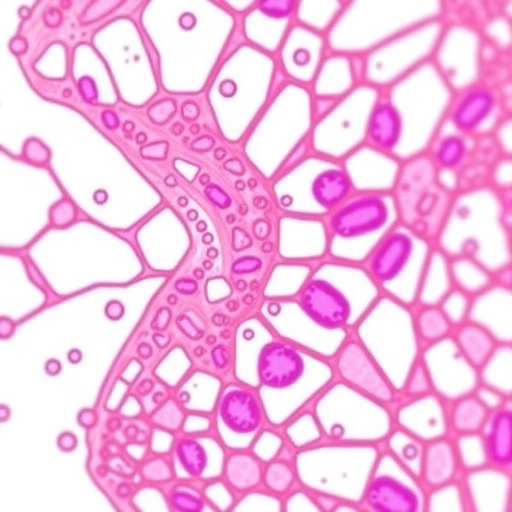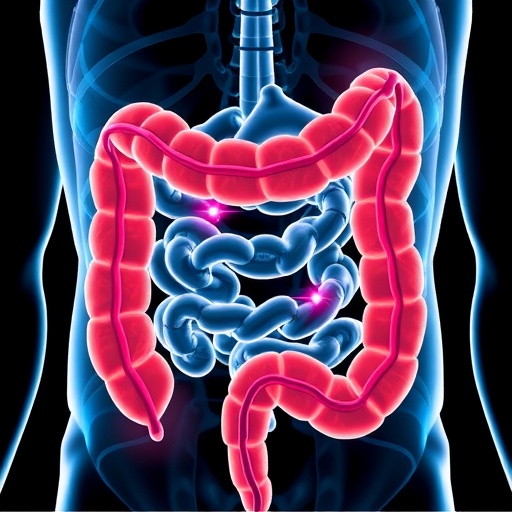Fusobacterium nucleatum, an anaerobic bacterium increasingly recognized for its role in colorectal cancer (CRC), has taken center stage in groundbreaking research that elucidates how this microorganism adheres to cancer cells. This interaction, pivotal in the progression of CRC, has long puzzled scientists due to its complexity and the bacterium’s ability to both colonize tumor microenvironments and suppress immune responses. Now, a collaborative study led by Professor George F. Gao’s team at the Institute of Microbiology, Chinese Academy of Sciences (CAS), reveals the intricate molecular mechanism behind this adhesion, offering a promising avenue for targeted cancer therapies.
The bacterium’s capability to bind to human cells is mediated by a specialized surface protein called CbpF, an autotransporter adhesin, which recognizes and binds to CEACAM1 and CEACAM5. These two cell surface receptors are often overexpressed in various cancers, providing an opportunistic docking platform for F. nucleatum. CEACAM1’s role is particularly notable, as it functions not only as an adhesion receptor but also as an inhibitory immune receptor, dampening immune cell activity once engaged. This dual functionality underscores the bacterium’s sophisticated strategy to both anchor and evade host defenses, a phenomenon that until now lacked detailed structural insight.
Employing cutting-edge cryo-electron microscopy techniques, Gao’s team successfully resolved high-resolution three-dimensional structures of the CbpF protein in complex with CEACAM1 and CEACAM5. Remarkably, their findings show that CbpF forms a trimeric assembly, with each monomer binding a single CEACAM molecule, resulting in a symmetric 3:3 stoichiometric complex. This trimeric adhesion complex demonstrates a coordinated multivalent binding mechanism, enhancing the overall strength and specificity of bacterial attachment to host cells, a key factor during colonization and infection.
Beyond this canonical trimer-receptor interaction, the researchers observed additional complex states involving two trimeric CbpF units binding to a CEACAM dimer. This higher-order assembly suggests that F. nucleatum can modulate its adhesion strength dynamically through cooperative receptor clustering. Such adaptability is crucial for bacterial survival within the highly variable microenvironment of the gut and tumor tissue, where mechanical forces and immune pressures constantly fluctuate.
To conceptualize these insights, the researchers proposed a novel “Velcro model” for bacterial adhesion. In this model, the flexible CbpF protein functions analogously to the loop component of Velcro, while the CEACAM receptors act like hooks. This multi-site, reversible interaction system allows the pathogen to fine-tune the adhesion strength at the molecular level, balancing attachment to tumor cells with the ability to detach as needed to navigate the complex physiological landscape. This dynamic regulation mechanism represents a significant leap forward in our understanding of microbial-host cell interactions.
The implications of this discovery extend beyond a mere structural curiosity. Since CEACAM1 engagement suppresses immune activation, F. nucleatum’s binding could directly contribute to immune evasion within the tumor microenvironment, promoting cancer progression and resistance to therapy. Therefore, targeting the CbpF-CEACAM interaction presents an attractive therapeutic strategy to disrupt this malignant crosstalk. Small molecules or antibodies that interfere with the binding interface could restore immune surveillance and hinder bacterial colonization on tumor cells.
This study also highlights the broader significance of bacterial adhesins in pathogenicity. Adhesion is not a static event but a highly regulated process tuned by both mechanical and biochemical cues. The Velcro adhesion paradigm uncovered here may be a generalized strategy among other pathogenic bacteria that interact with host tissues under mechanical stress. Understanding these mechanisms at the atomic level opens new horizons for designing anti-adhesion therapies as alternatives to conventional antibiotics.
From a technical standpoint, the use of cryo-electron microscopy was crucial in resolving these complexes at near-atomic resolution, overcoming challenges posed by the flexible and multimeric nature of the proteins involved. Such structural biology approaches complement biochemical and cellular assays, collectively painting a comprehensive picture of how F. nucleatum physically and functionally exploits host receptors to sustain and advance colorectal cancer.
The collaboration behind this work, involving Renji Hospital and Shanghai Jiao Tong University’s School of Medicine, exemplifies the interdisciplinary effort necessary to tackle complex biomedical problems. Supported by China’s National Key Research and Development Program, this research underscores the global commitment to understanding microbiome-cancer interactions and developing innovative therapeutic interventions.
As colorectal cancer remains a leading cause of cancer-related mortality worldwide, insights into microbial contributions to tumor biology could shift paradigms in oncological treatment. The identification of bacterial factors like CbpF that modulate tumor-immune dynamics provides a fresh perspective on managing cancers traditionally viewed through a solely human genetic lens.
Future directions for this line of research include exploring the in vivo relevance of these interactions using animal models, assessing how the mechanical forces in the gut environment influence adhesion dynamics, and screening for potent inhibitors of the CbpF-CEACAM interaction. Such efforts could lead to the development of novel drugs that complement existing cancer therapies and improve patient outcomes.
In summary, this study offers a detailed molecular explanation for how Fusobacterium nucleatum adheres to colorectal cancer cells through a cleverly orchestrated multivalent interaction using its CbpF adhesin and tumor-overexpressed CEACAM receptors. The elegant Velcro model not only advances our fundamental understanding of bacterial adhesion but also points toward innovative therapeutic strategies to combat cancer-associated bacterial infections and their immunosuppressive effects.
Subject of Research: Not applicable
Article Title: Binding of Fusobacterium nucleatum autotransporter adhesin CbpF to human CEACAM1 and CEACAM5: A Velcro model for bacterium adhesion
News Publication Date: 12-Sep-2025
Web References:
https://doi.org/10.1073/pnas.2516574122
References:
Gao, G.F. et al. Binding of Fusobacterium nucleatum autotransporter adhesin CbpF to human CEACAM1 and CEACAM5: A Velcro model for bacterium adhesion. Proceedings of the National Academy of Sciences, 2025.
Image Credits: Prof. George F. Gao’s group
Keywords:
Cancer treatments; Bacteria; Cancer cells; Adhesion; Host pathogen interactions; Binding partners
Tags: breakthroughs in cancer immunotherapyCbpF surface protein and cancerCEACAM1 CEACAM5 receptors in tumorscollaborative scientific research in oncologycryo-electron microscopy in microbiologyFusobacterium nucleatum colorectal cancer researchimmune evasion by bacteria in cancerinnovative colorectal cancer therapiesmicrobial adhesion mechanisms in cancermicrobial influence on cancer progressiontargeted cancer treatment strategiestumor microenvironment and bacteria





